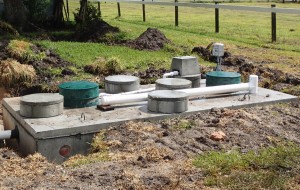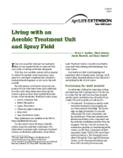 An aerobic treatment unit (ATU) consists of several processes that function together to provide a high quality effluent. These are gross solids (trash) removal, aeration, clarification, and sludge return. These processes are generally contained within separate chambers of a single tank. A series of tanks can be configured to have wastewater pass through an aerobic treatment train.
An aerobic treatment unit (ATU) consists of several processes that function together to provide a high quality effluent. These are gross solids (trash) removal, aeration, clarification, and sludge return. These processes are generally contained within separate chambers of a single tank. A series of tanks can be configured to have wastewater pass through an aerobic treatment train.
ATUs use biological processes to transform both dissolved and solid constituents into gases, cell mass, and non-degradable material. An important feature of the biological process is the synthesis and separation of microbial cells from the treated effluent.
The treatment process involves a variety of aerobic and facultative microorganisms living together that can decompose a broad range of materials. The organisms live in an aerobic environment where free oxygen is available for their respiration. ATUs can be used to remove substantial amounts of BOD5 and TSS that are not removed by simple sedimentation in a conventional septic system.
The biological process also involves the nitrification of ammonia in the wastewater and the reduction of pathogenic organisms. Nitrification is the breakdown of ammonia (NH3+) to nitrate (NO3-) by microorganisms in aerobic conditions.
ATUs, which are certified as Class I aerobic systems, treat wastewater well enough to be used in conjunction with spray systems, which distribute treated wastewater over lawns. Combined with disinfection, they are the most common way to treat wastewater for spray systems.
Related Resources:
 Operation and Maintenance Checklist: Aerobic Treatment Unit
Operation and Maintenance Checklist: Aerobic Treatment Unit
 Homeowner manual: “Checking my Aerobic System”
Homeowner manual: “Checking my Aerobic System”
 Aerobic Treatment Units (and in Spanish)
Aerobic Treatment Units (and in Spanish)
 Living with an Aerobic Treatment Unit and Spray Field
Living with an Aerobic Treatment Unit and Spray Field